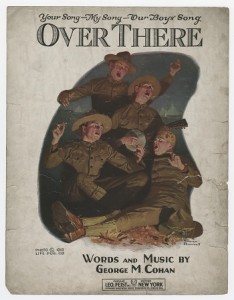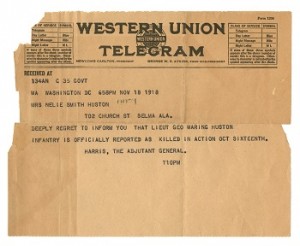By: Martha Bace, Processing Archivist
This week, we are featuring a series of blog posts dedicated to our current exhibition up in the Pearce Foyer of Gorgas Library. The exhibition, “Glimpses of the Great War, Abroad and At Home,” was curated by Martha Bace and Patrick Adcock and will be on view until mid-September. Read the first post of this series from Monday.
Other items on display represent life on the home front. Scrapbooks kept by Janie Mae Epps and Mrs. Oscar Hall show how the war was viewed by those left waiting for fathers, brothers, husbands, and friends to come home. Newspapers were eagerly examined by those anxiously waiting for the latest word from the front. The entertainment industry also did its part boosting morale with songs like “Over There,” “Keep the Home Fires Burning,” “Oh! How I Hate to Get Up in the Morning,” “After the War is Over,” and “When You Come Back.” The sheet music for these and many other patriotic and sentimental favorites could be found in most homes across the nation.
Of particular note to me are the service flag and letters. The service flag, featuring a white field bordered in red with blue or gold stars, hung in the windows of homes where a member of the family was serving in the Armed Forces. The flags, which are still in use today, had one blue star for each family member serving. However, the blue star was changed to gold if the family received notice of the death of their soldier. And with the service flag, there are the letters… letters written by wide-eyed young men who had probably never been more than one hundred miles from their birthplace before… letters written by young men longing to be home with loved ones at Christmas… letters from soldiers describing the French and Italian countryside and the vehicles used by the Red Cross… letters written just to say “I’m fine” and “I was so happy to get your letter.”
All these letters are interesting, but probably the most poignant item to me in the entire exhibit is the War Department telegram from the collection of the Huston family papers. It was sent on November 18, 1918 – seven days after the Armistice was signed, stating that Lieutenant George Waring Huston was killed in action on October 16th. You have to think that on November 11th, his family in Selma, Alabama, was jubilant thinking that their son would be coming home soon, only to have those happy thoughts crushed by a single sentence on a small tan piece of paper, just seven short days later. Looking at the faces of these men and boys you see in the photos of this exhibit, most of whom are unidentified, you have to wonder if they made it back to the arms of their loved ones, or if instead, those patiently waiting loved ones also received one of the small, sparsely worded telegrams.
It has been fascinating to me to see this war – this “Great War” – virtually at first hand. Reading the letters… examining the uniforms… looking at the faces of the soldiers… reminds me that many of us have a portion of this war in our pasts. In my own family’s history, my recently wed great aunt, Catherine Smith, waited at home for her husband, Sergeant Oscar M. Smith. Oscar was mortally wounded going “over the top” near Marne, France, on October 9, 1918; he died in hospital the following day – one month and two days before it was over, over there. His is just one story among millions, and the University Libraries Division of Special Collections is fortunate to be the repository of many of them.


